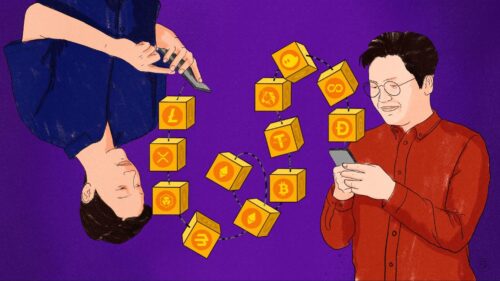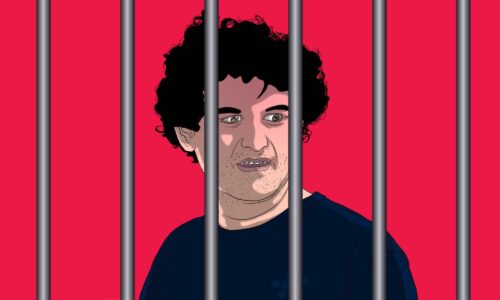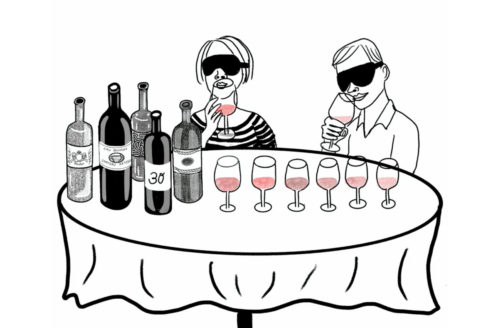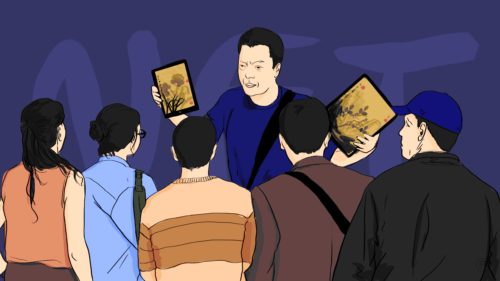NFTs in the P.R.C. — crypto art craze comes to China
Non-fungible tokens, or NFTs, took the international art world by storm in March after the sale of a piece of digital art for nearly $70 million. The Chinese art world and China’s many cryptocurrency entrepreneurs are taking note.

Crypto art in the form of non-fungible tokens, or NFTs, took the international art world by storm in March after the sale of a piece of digital art by 250-year-old British auction house Christie’s for nearly $70 million. The Chinese art world and China’s many cryptocurrency entrepreneurs are taking note.
China has a crypto art market too: Hundreds of WeChat groups are now dedicated to the art form, and Weibo is flooded with explanatory videos that garner millions of views.
Can Chinese crypto art ‘break the circle’
Diana Tang, the founder of CryptoC, an NFT community in China, got into the NFT scene in 2019 when she was the editor-in-chief of a Chinese crypto publication. Back then, she recalled the popularity of CryptoPunks, a collection of 10,000 miniature cartoon avatar heads. The cartoons, like all NFTs, could be officially owned by a single person online through the Ethereum blockchain. At first, individual members of the crypto community could claim them for free. Later, she told The China Project, one avatar got sold for $800. Now, the same one can sell for millions of dollars. (Example: Punk #2212, a female with blue eye shadow, now costs $42,459.03.)
In early April, an art gallery in Beijing opened its doors to the first-ever crypto art exhibition. Featuring digital artists from both the East and the West, the showcase was curated by Sūn Bóhán 孙博涵, the CEO of BlockCreateArt (BCA), Asia’s first crypto art trading platform. (BCA recently raised $2 million from angel investors, making it the largest NFT-related business in China.) The exhibit notably featured the works of Beeple, the crypto artist behind Christie’s first-ever digital art sale.
Some crypto art is traded on Chinese platforms. The Chinese-developed Binance (in Chinese), the largest crypto currency exchange in the world, began experimenting with NFTs back in 2019. Like CryptoPunks, Binance NFTs began as gift giveaways, but now, the most valuable of the giveaways — titled Exchange the World 2019 — is selling for $236,419.20.
Chinese artists are also bringing a traditional flair to their crypto art. Tang said that one artist she knew was working on a piece that combines Buddhist themes with cyberpunk aesthetics. According to Allen Ng, the CEO and founder of blockchain company Everest Ventures Group, crypto artists are trying to attract people outside the traditional crypto space, a mission he referred to as “breaking the circle” (破圈).
Toward that end, some crypto art is now taking the form of music and entertainment. This month, Singaporean Chinese singer Chén Huànrén 陈奂仁 issued (Chinese report) the first NFT music piece in the greater China area, “Nobody Gets Me.” The work sold for seven Ethereums ($16,335 as of April 23). In an interview with CryptoC, Tan noted the immense potential of NFTs for artists who have long struggled with the rights to their music. “NFTs may usher in a new dawn for the next generation of Chinese-speaking musicians,” he said. “That’s why I decided to be a guinea pig and test whether NFTs could make it in the Chinese music market.”
Why so expensive?
Part of the reason NFTs can sell at jaw-dropping rates comes from their irreplaceability. Unlike bitcoins, which are “fungible tokens” — meaning that one bitcoin is no different from the next — non-fungible tokens are as distinct as actual artworks. “If your work has scarcity in a non-blockchain scenario, your work will have double the scarcity on the blockchain,” Ng told The China Project.
That means the owner of Punk #2212 can now authenticate their ownership claims, and sell the avatar for more if the market supports it. The unfathomable sale prices of some NFTs — such as Twitter CEO Jack Dorsey’s first tweet, which sold for $2.5 million in March — almost certainly have nothing to do with the quality of the artwork, but the speculative expectation that the value will eventually rise.
There is a second explanation to NFT’s sky-high prices. According to Ng, members of the NFT and cryptocurrency circles have often earned a fortune from trading cryptocurrencies and so they can afford to pay such prices in anticipation of future value. In Tang’s words, these hobbyists make up the “new money class” (新贵阶级).
“In human history, the rise of new social classes also ushered in the rise of new art genres,” Tang told The China Project.
The pandemic has also undoubtedly spurred the NFT craze in China. With offline art shows suspended, many artists have looked to the digital world for new sources of income.
No permission required
Despite all the hype, crypto art, or NFT, is “still too early in China,” said a blockchain expert to Decrypt, a crypto news site. “The Chinese art market has an extremely poor understanding of crypto art.” Indeed, Tang and Ng noted that the market is still immature: While many artists can join the NFT game, there are still relatively few buyers in China.
Nonetheless, crypto art has a lot of potential. “For the first time, artists can plug into a permissionless network that allows them to freely express sensitive topics such as power, regulation, subculture, authority, individualism, and collective vulnerability,” writes Shuyao Kong, a writer at Decrypt. “They are not restricted by physical space nor censorship.”
For a country where the presence of government can run up against one’s artistic and creative habits, the nascent crypto art scene may give creative personalities a new space in which to experiment without the constant fear of political sanction. The value of that opportunity may be priceless.
“There may be bubbles in NFTs in the short run, but in the long run, NFTs are undervalued,” said Ng.






